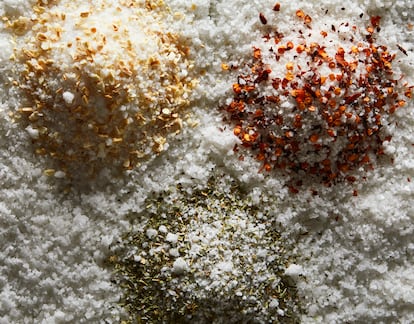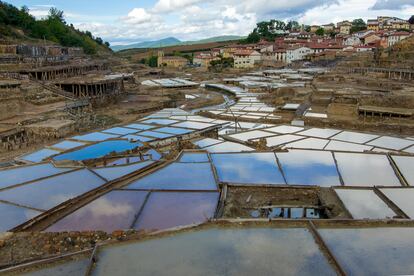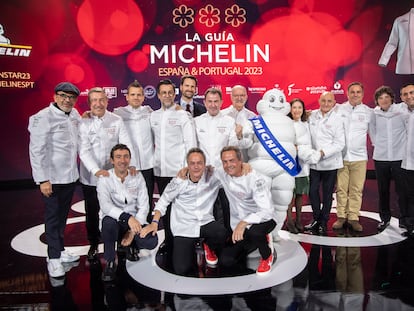Salt experiences its most gastronomic moment
Salt farmers are innovating with original aromatized and seasoned varieties, and chefs are praising their work

It is the most used rock in gastronomy. It is not just another ingredient. Even its history is linked to economic activities — for instance, the word “salary” comes from the Latin term salarium; in the time of the Roman Empire, soldiers and public officials were paid in salt, a valued product. Whoever delves into the topic gets hooked. This is what happened to Eneko Atxa, chef and owner of the Azurmendi restaurant in Spain’s Basque Country, who discovered this universe through the Valle Salado de Añana project. “I fell in love with the salt stalactites and everything they do there; I even have my own plot, from which they extract salt for our restaurants.” His interest in this condiment seems to have no limit; he is currently working on a specific variety to make venison marinades. “It brings nuances to any dish.” Firmness, too. To achieve this, Atxa has a trick: he covers the fish with salt for about seven minutes. “It absorbs it and makes the meat firmer.” It also adds aromas. “It’s exciting,” the chef admits.
The salt producers also know this, and although they continue to sell the classic natural and mineral white salt in different textures, they are also exploring a new category: aromatized and seasoned salt. Those in Añana are inland salt flats; the water does not come from the sea. The salt there is the result of the natural evaporation of brine or salt water that comes from the springs of Valle Salado de Añana. A magical place, explains Alberto Plata, a spokesperson for the foundation that manages this complex: “Salt now has recognition.” The salt farmers sensed that there was a market for it.
“We have fought a lot to get people to try them. At first we gave them away. People got hooked, because they provide a different flavor to all the dishes. We work with 34 varieties of spices, such as oregano, garlic, curry, hibiscus, ñora, thyme or paprika,” says Manuela Gómez, owner of Salinas Biomaris (formerly known as Salinas del Alemán, established in 1954), in Isla Cristina, Huelva, Spain. After taking over from her father in 2003, she began to produce three artisanal varieties: salt flakes, virgin sea salt and fleur de sel.

The estuaries are one of the most precious jewels in Cádiz, southern Spain. “A tradition that is being lost and that must be reclaimed by consuming real salt,” explains Ángel León, chef at the Aponiente restaurant. That is the salt they produce at Salina San Vicente, a Cádiz family business that dates back to 1725 and whose philosophy is to make the same seasoning that grandmothers used to cook with, avoiding the kind of suspicious labels that say things like “virgin sea salt,” as they are industrial.
Unlike the extensive salt flats of the large crystallizers, where the salt is collected once a year, at the Fuencaliente salt flat, in Santa Cruz de la Palma, Spain, seven or eight harvests are carried out a year, although now, according to Andrés Hernández, manager and third generation in the family business, they are also focusing on organic mango, lemon and pepper, red and green mojo, or wine salts. “In order to survive, we have to innovate.” There is a salt for every recipe, says Plata, who advises using flower salt to finish a dish, coarse salt for cooking, liquid salt for salads, fish and paellas, and cayenne, garlic, or wine salt for meats.
Sign up for our weekly newsletter to get more English-language news coverage from EL PAÍS USA Edition
Tu suscripción se está usando en otro dispositivo
¿Quieres añadir otro usuario a tu suscripción?
Si continúas leyendo en este dispositivo, no se podrá leer en el otro.
FlechaTu suscripción se está usando en otro dispositivo y solo puedes acceder a EL PAÍS desde un dispositivo a la vez.
Si quieres compartir tu cuenta, cambia tu suscripción a la modalidad Premium, así podrás añadir otro usuario. Cada uno accederá con su propia cuenta de email, lo que os permitirá personalizar vuestra experiencia en EL PAÍS.
¿Tienes una suscripción de empresa? Accede aquí para contratar más cuentas.
En el caso de no saber quién está usando tu cuenta, te recomendamos cambiar tu contraseña aquí.
Si decides continuar compartiendo tu cuenta, este mensaje se mostrará en tu dispositivo y en el de la otra persona que está usando tu cuenta de forma indefinida, afectando a tu experiencia de lectura. Puedes consultar aquí los términos y condiciones de la suscripción digital.
More information
Archived In
Últimas noticias
Welcome to the post-religion era: The idea of Christianity as the absolute truth has become obsolete
‘I thought you would like it’: The risky sexual practice popularized by TV shows and TikTok
The digitalization of tourism: ‘They promise experiences and gave us the worst possible one’
Mexican peso defies uncertainty with forecasts of a new period of stability in 2026
Most viewed
- Sinaloa Cartel war is taking its toll on Los Chapitos
- Oona Chaplin: ‘I told James Cameron that I was living in a treehouse and starting a permaculture project with a friend’
- Reinhard Genzel, Nobel laureate in physics: ‘One-minute videos will never give you the truth’
- Why the price of coffee has skyrocketed: from Brazilian plantations to specialty coffee houses
- Silver prices are going crazy: This is what’s fueling the rally











































